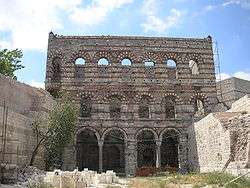Porphyrogennetos

Porphyrogénnētos (Latinized as Porphyrogenitus) (Greek: Πορφυρογέννητος, literally "born in the purple") was an honorific title in the Byzantine Empire given to a son, or daughter (Πορφυρογέννητη, Porphyrogénnētē, Latinized Porphyrogenita), born after the father had become emperor.[1] In addition to this, the birth had to meet other conditions in order for the title to apply.
Background
The concept of porphyrogennetos was known from the sixth century in connection with growing ideas of hereditary legitimacy but the first secure use of the word is not found until 846.[1] The term became common by the 10th century, particularly in connection with Emperor Constantine VII Porphyrogenitus, and its use continued into the Palaiologan period.[1]
Imperial purple was a luxury dye obtained from sea snails, used to colour cloth. Its production was extremely expensive, so the dye was used as a status symbol by the Romans e.g. a purple stripe on the togas of magistrates. By the Byzantine period the colour had become associated with the emperors, and sumptuary laws restricted its use by anyone except the imperial household. Purple was thus seen as an imperial colour.
The Porphýra/Porphyry Chamber
Constantine VII, who was himself porphyrogénnētos, described the ceremonies which took place during the birth of a porphyrogénnētos child in his work De Ceremoniis aulae byzantinae.[1]

The most distinctive condition was that the child be born in the "Πορφύρα" (Porphýra, the Purple or Porphyry Chamber, a pavilion of the Great Palace of Constantinople): no child born anywhere else could legitimately be called Porphyrogénnētos. This pavilion was a free-standing building in the Great Palace complex in Constantinople. As the Porphyrogennētē Anna Komnena described it, the room rested on one of the Palace's many terraces, overlooking the Sea of Marmora and the Bosphorus Strait, "where the stone oxen and the lions stand" (i.e. the Boukoleon Palace), and was in the form of a perfect square from floor to ceiling, with the latter ending in a pyramid. Its walls, floor and ceiling were completely veneered with imperial porphyry, which was "generally of a purple colour throughout, but with white spots like sand sprinkled over it."[2]

The Palace of the Porphyrogenitus is a late 13th-century Byzantine palace in the north-western part of the old city of Constantinople named after Constantine Palaiologos (son of Michael VIII).
Basileus and Augusta
The other important qualification for status as a Porphyrogénnētos was that the father must be a reigning Basileus (Greek: βασιλεύς, the Greek word for King or Emperor), and the mother must be married to the Basileus (and therefore an empress) and additionally must have undergone a formal, sacred ceremony creating her an Augusta.
Diplomacy
In Imperial diplomacy a porphyrogénnēta bride was sometimes sent to seal a bargain, or a foreign princess may have gone to Constantinople to marry a porphyrogénnētos. Liutprand of Cremona, for instance, visited Constantinople in 968 on a diplomatic mission from Otto I to secure a purple-born bride for the prince who would eventually become Otto II, in which mission he failed.[3] A different bride who wasn't purple-born, Theophanu Skleraina, was subsequently acquired in 971.[4]
References
- 1 2 3 4 "Porphyrogennetos" in The Oxford Dictionary of Byzantium, Oxford University Press, New York & Oxford, 1991, p. 1701. ISBN 0195046528
- ↑ Comnena, Anna (2003), The Alexiad, London: Penguin, pp. 196, 219, ISBN 0-14-044958-2.
- ↑ "Liudprand of Cremona - a diplomat?" by Constanze M.F. Schummer in Shepard J. & Franklin, Simon. (Eds.) (1992) Byzantine Diplomacy: Papers from the Twenty-fourth Spring Symposium of Byzantine Studies, Cambridge, March 1990. Aldershot: Variorum, p. 197.
- ↑ "LIUTPRAND OF CREMONA" in The Oxford Dictionary of Byzantium, Oxford University Press, New York & Oxford, 1991, p. 1241. ISBN 0195046528